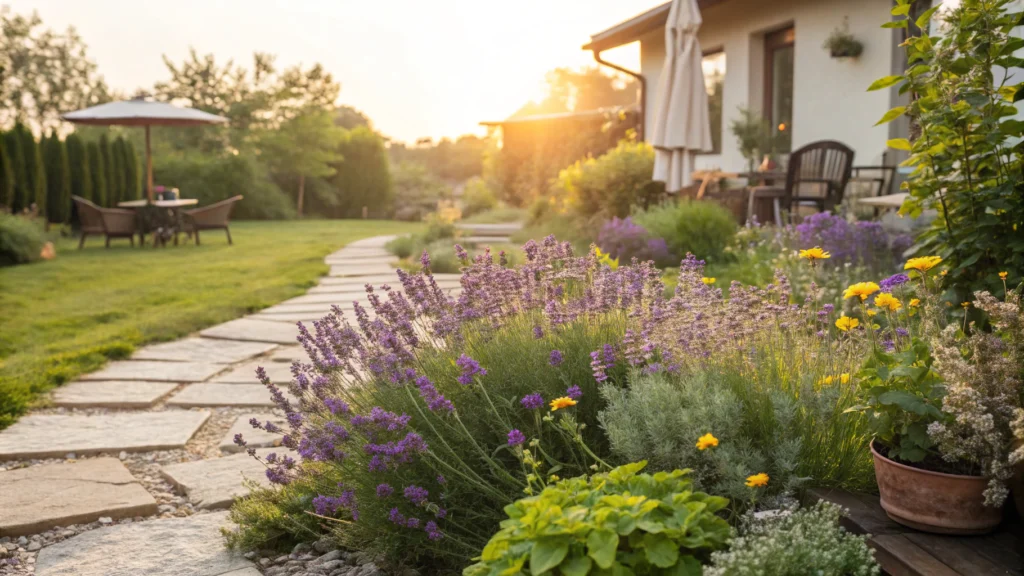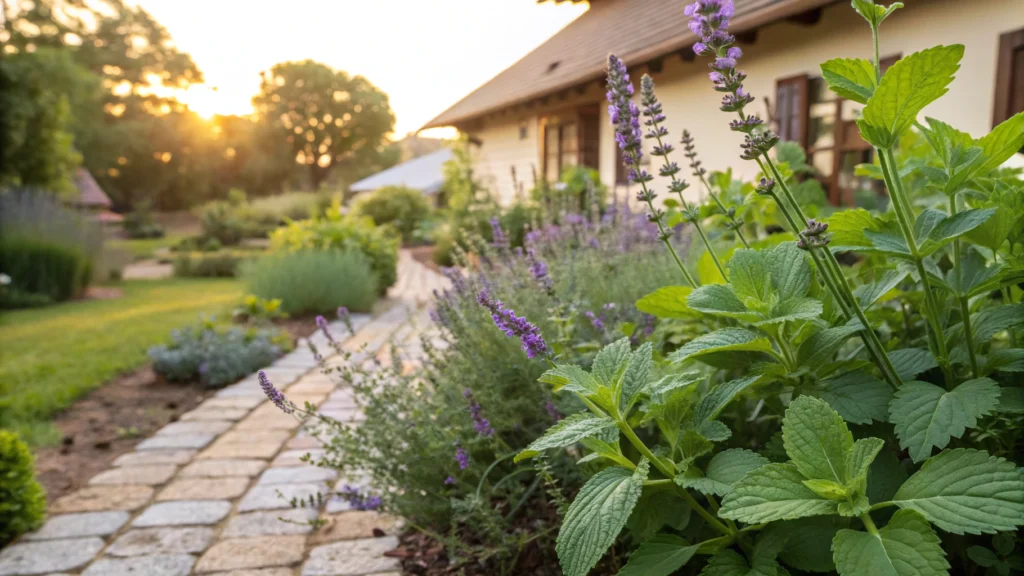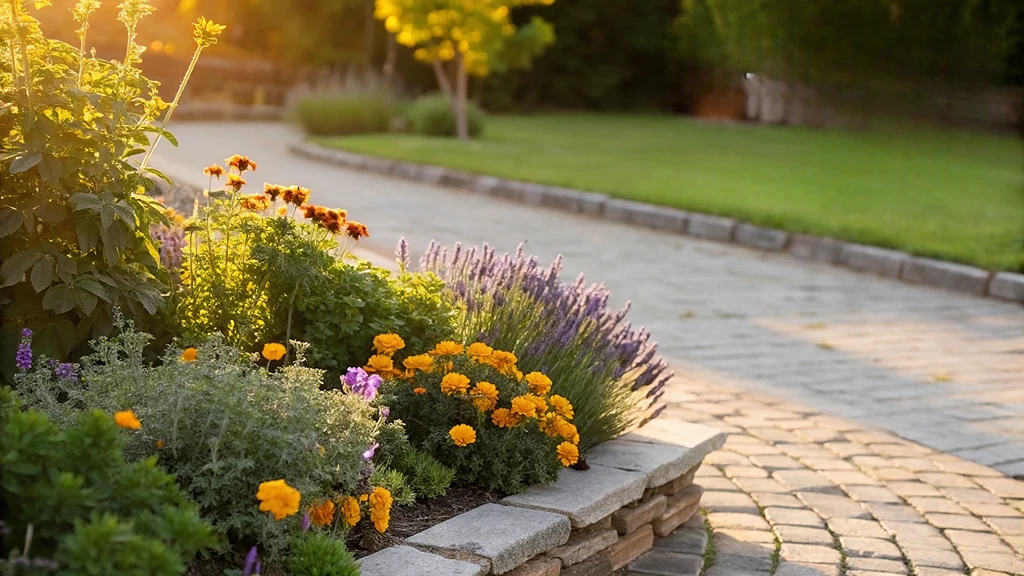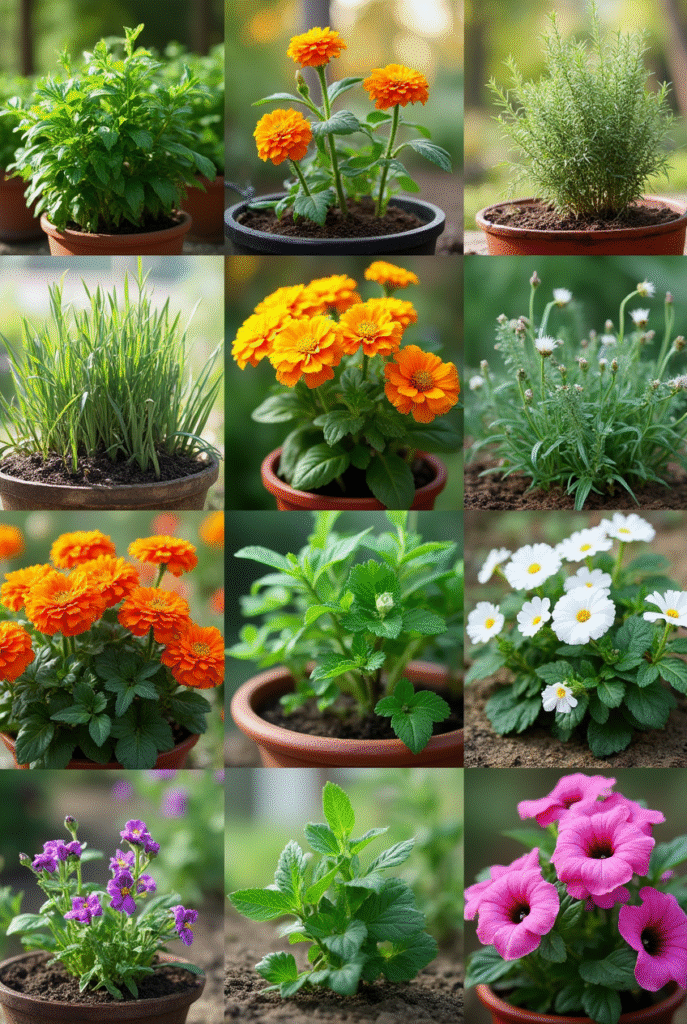Have you ever spent hours perfecting your garden only to watch insects devour your prized plants? Or perhaps you’ve planned an outdoor dinner that quickly turned into a buffet—for mosquitoes? I’ve been there too, swatting and spraying, feeling frustrated as chemical repellents failed to solve the problem while potentially harming beneficial insects and contaminating my homegrown produce.
After years of gardening and researching natural solutions, I’ve discovered that nature already provides the perfect answer: pest-repelling plants. These botanical defenders not only keep bugs away naturally but also enhance your garden’s beauty and biodiversity—a win-win solution that works with nature rather than against it.
In this comprehensive guide, I’ll share my top 10 plants that keep bugs away naturally, complete with planting tips, companion combinations, and practical applications that will transform your outdoor spaces into pest-resistant havens.
Table of Contents
Why Natural Pest Control Matters in Your Garden
Chemical pesticides might offer quick results, but they come with significant drawbacks:
- They kill beneficial insects along with pests
- They can contaminate soil and water sources
- They may pose health risks to humans, pets, and wildlife
- They require frequent reapplication
Plants that naturally repel insects, on the other hand, work continuously, safely, and often enhance your garden’s appearance and ecosystem. Research from the University of Florida shows that integrated pest management using repellent plants can reduce the need for chemical interventions by up to 50%.
How Plants Naturally Repel Insects
Plants have evolved sophisticated defense mechanisms over millions of years. They produce specialized compounds called secondary metabolites that serve various protective functions—including keeping hungry insects at bay.
These natural insect repellents work through several mechanisms:
| Mechanism | How It Works | Examples |
|---|---|---|
| Olfactory Repellents | Strong-smelling compounds confuse or repel insects | Lavender, rosemary, mint |
| Taste Deterrents | Bitter compounds make plants unpalatable | Marigolds, nasturtiums |
| Contact Irritants | Substances that harm insects upon contact | Chrysanthemums, pyrethrum |
| Masking Compounds | Scents that hide the smell of companion plants | Basil, thyme |
Now let’s explore the ten most effective plants that keep bugs away from your garden.
The 10 Most Effective Plants That Keep Bugs Away
1. Lavender: The Fragrant Protector
Lavender doesn’t just delight humans with its soothing scent—it actively repels mosquitoes, moths, fleas, flies, and even some beetles.
What it repels: Mosquitoes, moths, fleas, flies
How to grow: Plant in full sun with well-drained soil. Lavender thrives in slightly alkaline conditions and requires minimal watering once established.
Best varieties for pest control: Lavandula angustifolia (English lavender) and Lavandula x intermedia (lavandin) contain the highest concentrations of repellent compounds.
Pro tip: Plant lavender along walkways, near seating areas, or around vegetable gardens to create protective aromatic barriers.

2. Marigolds: The Colorful Garden Guards
Marigolds contain pyrethrum, a compound commonly used in commercial insecticides, making them powerful natural bug repellents despite their cheerful appearance.
What they repel: Aphids, mosquitoes, whiteflies, nematodes (soil pests)
How to grow: Plant in full sun after all danger of frost has passed. They thrive in average soil and are drought-tolerant once established.
Best varieties for pest control: French marigolds (Tagetes patula) are particularly effective against nematodes, while Mexican marigolds (Tagetes minuta) contain the highest concentration of repellent compounds.
Pro tip: Plant marigolds as borders around vegetable gardens or interspersed between susceptible plants to create a pest barrier.
3. Basil: The Culinary Protector
This kitchen favorite does double duty in the garden, providing fresh herbs for your meals while keeping mosquitoes and flies at bay.
What it repels: Mosquitoes, flies, carrot flies
How to grow: Plant in rich, moist soil in full to partial sun. Basil is tender and should be planted after all danger of frost.
Best varieties for pest control: Lemon basil and cinnamon basil have especially potent repellent properties.
Pro tip: Grow basil near tomatoes—it improves their flavor while protecting them from hornworms and other pests.
4. Rosemary: The Aromatic Defender
This woody perennial’s intense aroma makes it an excellent insect repellent with the bonus of culinary and medicinal uses.
What it repels: Mosquitoes, cabbage moths, carrot flies
How to grow: Plant in well-drained soil in full sun. Rosemary is drought-tolerant once established but needs good drainage to prevent root rot.
Best varieties for pest control: Upright varieties like ‘Tuscan Blue’ and ‘Arp’ contain high concentrations of repellent oils.
Pro tip: Plant rosemary near cabbage, carrots, and beans to protect them from their common pests.
5. Chrysanthemums: The Powerful Pest Controllers
Chrysanthemums contain pyrethrin, one of nature’s most effective insect repellents and the basis for many commercial insecticides.
What they repel: Roaches, ticks, fleas, ants, Japanese beetles, spider mites, silverfish, lice
How to grow: Plant in rich, well-drained soil in full sun to light shade. Pinch young plants to encourage bushiness.
Best varieties for pest control: Chrysanthemum cinerariifolium and C. coccineum contain the highest concentrations of pyrethrins.
Pro tip: Dried chrysanthemum flowers can be ground and sprinkled around the garden for additional pest control.
6. Mint: The Invasive Protector
With its aggressive growth habit and strong scent, mint is a powerful pest deterrent that needs careful management.
What it repels: Ants, mosquitoes, mice, cabbage moths
How to grow: Plant in containers to prevent spreading, as mint is highly invasive. Provide partial shade and regular water.
Best varieties for pest control: Peppermint and spearmint are particularly effective against most pests.
Pro tip: Place containers of mint around outdoor seating areas and entries to deter mosquitoes and flies from approaching your home.

7. Citronella Grass: The Classic Mosquito Repellent
This tropical grass is the source of citronella oil, widely recognized for its mosquito-repelling properties.
What it repels: Mosquitoes, flies
How to grow: In warm climates (USDA zones 9-11), plant in rich, well-drained soil in full sun. In colder areas, grow in containers and bring indoors for winter.
Best varieties for pest control: Cymbopogon nardus and Cymbopogon winterianus contain the highest levels of repellent compounds.
Pro tip: Crush or bruise the leaves before outdoor gatherings to release more of the repellent oils.
8. Nasturtiums: The Beautiful Sacrificial Plants
These colorful flowers can serve as “trap plants,” attracting aphids away from more valuable crops.
What they repel/trap: Aphids, whiteflies, squash bugs, cucumber beetles
How to grow: Plant in average to poor soil in full sun or partial shade. They actually bloom better in less fertile soil.
Best varieties for pest control: Climbing varieties can cover more area when used as trap crops.
Pro tip: Plant nasturtiums around the perimeter of your vegetable garden to draw pests away from your food crops.
9. Catnip: The Surprisingly Effective Deterrent
Research at Iowa State University found that catnip is ten times more effective at repelling mosquitoes than DEET.
What it repels: Mosquitoes, cockroaches, ants, Japanese beetles
How to grow: Plant in full sun to partial shade in well-drained soil. Like mint, it can be invasive, so consider container planting.
Best varieties for pest control: Nepeta cataria (common catnip) has the highest concentration of nepetalactone, the repellent compound.
Pro tip: Make a natural bug spray by steeping catnip leaves in hot water, cooling, and transferring to a spray bottle.
10. Petunias: The Colorful Pest Controllers
These popular ornamental flowers aren’t just pretty—they’re working hard to repel several common garden pests.
What they repel: Aphids, tomato hornworms, asparagus beetles, leafhoppers
How to grow: Plant in rich, well-drained soil in full sun. Deadhead regularly to encourage continuous blooming.
Best varieties for pest control: All varieties offer some pest protection; choose based on your color preference and garden design.
Pro tip: Plant petunias around the base of vegetables like tomatoes and peppers to protect them while adding color to your vegetable garden.
Strategic Planting: Maximizing Bug-Repelling Effectiveness
Creating an effective pest-repellent garden goes beyond simply including these plants—strategic placement is key to maximizing their protective potential.
Create Aromatic Borders
Plant strongly scented repellent plants like lavender, rosemary, and mint around the perimeter of your garden to create a protective barrier. This aromatic fence confuses and deters insects before they can reach more vulnerable plants.
Practice Companion Planting
Companion planting pairs pest-repelling plants directly with vulnerable crops:
- Plant basil near tomatoes to repel tomato hornworms
- Surround cabbage family plants with thyme to deter cabbage worms
- Interplant marigolds throughout the vegetable garden to control nematodes
- Plant nasturtiums near cucumbers and squash to draw aphids away
Develop Pest-Repelling Container Combinations
For patios and small spaces, create container plantings that both repel pests and look beautiful:
- Mosquito-Repelling Pot: Citronella grass as a centerpiece, surrounded by lavender and marigolds
- Kitchen Herb Defender: Basil, rosemary, and mint in one container (with mint in its own compartment to control spreading)
- Colorful Pest Control: Petunias and nasturtiums cascading from a hanging basket near vegetable gardens
Beyond Planting: Enhancing Your Natural Pest Control
While plants that keep bugs away form the foundation of natural pest management, combining them with these complementary strategies creates a comprehensive approach:
Attract Beneficial Insects
Not all insects are pests—many are garden allies that prey on problematic bugs:
- Plant dill, fennel, and cosmos to attract ladybugs, which devour aphids
- Include flowering herbs like oregano and thyme to attract parasitic wasps that control caterpillars
- Add flowering plants like alyssum and zinnias for hover flies, which feed on aphids and other soft-bodied pests
Maintain Garden Health
Healthy plants naturally resist pests better than stressed ones:
- Ensure proper watering and nutrition
- Practice crop rotation to prevent pest buildup
- Remove dead or diseased plant material promptly
- Use mulch to regulate soil temperature and moisture
DIY Natural Pest-Repellent Preparations
Enhance the power of your pest-repellent plants by creating natural sprays and preparations:
Herb-Infused Pest Spray:
- 1 cup fresh herbs (mix of rosemary, mint, lavender, and thyme)
- 4 cups boiling water
- 1 teaspoon mild liquid soap (optional)
Steep herbs in water until cooled, strain, add soap if desired, and spray on plants to deter soft-bodied pests.
Seasonal Considerations for Pest-Repelling Gardens
Different seasons bring different pest challenges. Here’s how to adapt your plant-based pest control throughout the year:
Spring
- Start seeds of annual pest-repelling plants like basil and marigolds indoors
- Divide established mint, catnip, and other spreading perennials to increase coverage
- Apply compost to support healthy plant growth and natural pest resistance
Summer
- Regularly harvest herbs like basil and mint to stimulate new growth and increased oil production
- Deadhead flowers like marigolds and petunias to encourage continuous blooming and pest protection
- Monitor for signs of pest pressure and adjust your planting strategy accordingly
Fall
- Collect seeds from annual pest-repelling plants for next year
- Harvest and dry herbs for winter use in homemade pest-repellent sachets
- Plant spring-blooming bulbs like alliums, which have pest-repellent properties
Winter
- Bring tender perennials like citronella grass indoors in cold climates
- Plan next year’s garden layout to optimize pest-repelling companion plantings
- Research and source seeds for additional pest-repelling varieties to try
Real-World Success Stories
Sarah from Arizona transformed her mosquito-ridden backyard into a pest-free oasis by strategically planting lavender, citronella grass, and basil around her patio. “We can finally enjoy evening dinners outside without being eaten alive,” she reports.
Urban gardener Miguel in Chicago struggled with aphids destroying his container vegetables until he introduced nasturtiums and marigolds. “The aphids now prefer the nasturtiums, leaving my peppers and tomatoes untouched,” he explains.
Community garden coordinator Janice implemented a border of pest-repelling plants around their entire garden, reducing pest problems for all members. “We’ve cut our pest issues by about 70% without any synthetic chemicals,” she notes.
FAQ About Plants That Keep Bugs Away
What plant repels the most insects?
Citronella is one of the most effective insect-repelling plants. Its strong citrus scent naturally keeps mosquitoes, flies, and other bugs at bay. Other top contenders include lavender, marigold, and lemongrass.
What plants can I put on my porch to keep mosquitoes away?
Try placing basil, mint, citronella, lavender, or marigolds on your porch. These plants give off natural scents that repel mosquitoes while adding color and fragrance to your outdoor space.
What smell do all bugs hate the most?
Bugs tend to hate strong, pungent scents like peppermint, citronella, garlic, eucalyptus, and lavender. These smells overwhelm their senses and can be used to create a bug-repellent garden or natural spray.
How do I stop bugs from eating my vegetable garden?
Use companion planting with pest-repelling herbs likebasil, rosemary, and chives, and introduce beneficial insects like ladybugs. Keep your garden clean and use natural sprays like neem oil to prevent infestations.
Conclusion:
Creating a garden that naturally keeps bugs away isn’t about eliminating all insects—it’s about establishing balance. By incorporating these ten powerful pest-repelling plants into your landscape, you’re working with nature’s own systems rather than fighting against them.
The beauty of this approach lies in its multifunctionality: many plants that keep bugs away also provide culinary herbs, beautiful flowers, and habitat for beneficial insects. Your garden becomes not just pest-resistant but more resilient, diverse, and sustainable.
As you implement these natural pest control strategies, remember that some trial and error may be necessary to find the perfect combinations for your specific conditions and pest challenges. Be patient, observe closely, and adjust as needed.
By choosing plants that keep bugs away naturally, you’re creating a healthier environment for your family, beneficial wildlife, and the planet—all while enjoying a more beautiful, productive garden with fewer pest problems.
For more gardening tips follow us on Pinterest

